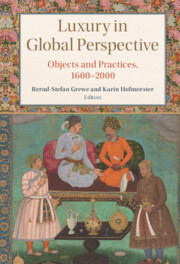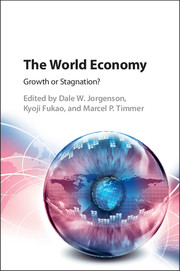Refine search
Actions for selected content:
26946 results in Economic history
EDITORIAL NOTE
-
- Journal:
- Revista de Historia Economica - Journal of Iberian and Latin American Economic History / Volume 35 / Issue 1 / March 2017
- Published online by Cambridge University Press:
- 09 February 2017, pp. 3-10
- Print publication:
- March 2017
-
- Article
-
- You have access
- HTML
- Export citation
RHE volume 35 issue 1 Cover and Front matter
-
- Journal:
- Revista de Historia Economica - Journal of Iberian and Latin American Economic History / Volume 35 / Issue 1 / March 2017
- Published online by Cambridge University Press:
- 09 February 2017, pp. f1-f3
- Print publication:
- March 2017
-
- Article
-
- You have access
- Export citation
RHE volume 35 issue 1 Cover and Back matter
-
- Journal:
- Revista de Historia Economica - Journal of Iberian and Latin American Economic History / Volume 35 / Issue 1 / March 2017
- Published online by Cambridge University Press:
- 09 February 2017, pp. b1-b6
- Print publication:
- March 2017
-
- Article
-
- You have access
- Export citation
PORT WINE, BRAZIL AND THE WORLD ECONOMY: A TIME SERIES ANALYSIS FROM 1756 TO BRAZILIAN INDEPENDENCE*
-
- Journal:
- Revista de Historia Economica - Journal of Iberian and Latin American Economic History / Volume 35 / Issue 2 / September 2017
- Published online by Cambridge University Press:
- 23 January 2017, pp. 275-300
- Print publication:
- September 2017
-
- Article
-
- You have access
- HTML
- Export citation
HOW INDUSTRIALISED WAS MEXICO BY 1929? A SMALL BUT NECESSARY CORRECTION TO MEXICO’S NATIONAL ACCOUNTS*
-
- Journal:
- Revista de Historia Economica - Journal of Iberian and Latin American Economic History / Volume 35 / Issue 2 / September 2017
- Published online by Cambridge University Press:
- 23 January 2017, pp. 301-318
- Print publication:
- September 2017
-
- Article
-
- You have access
- HTML
- Export citation

Luxury in Global Perspective
- Objects and Practices, 1600–2000
-
- Published online:
- 12 January 2017
- Print publication:
- 28 November 2016
BIOLOGICAL WELFARE AND NUTRITIONAL INEQUALITY IN RURAL MEDITERRANEAN SPAIN: THE IRRIGATED AREA OF VALENCIA, 1859-1939*
-
- Journal:
- Revista de Historia Economica - Journal of Iberian and Latin American Economic History / Volume 35 / Issue 1 / March 2017
- Published online by Cambridge University Press:
- 09 January 2017, pp. 11-47
- Print publication:
- March 2017
-
- Article
-
- You have access
- HTML
- Export citation
Economically irrational pricing of nineteenth-century British government bonds
-
- Journal:
- Financial History Review / Volume 23 / Issue 3 / December 2016
- Published online by Cambridge University Press:
- 09 January 2017, pp. 277-302
-
- Article
-
- You have access
- HTML
- Export citation

The World Economy
- Growth or Stagnation?
-
- Published online:
- 07 January 2017
- Print publication:
- 24 November 2016
3 - The Concepts
-
- Book:
- Worker Voice
- Published by:
- Liverpool University Press
- Published online:
- 12 July 2017
- Print publication:
- 31 December 2016, pp 60-88
-
- Chapter
- Export citation
Table of Contents
-
- Book:
- Worker Voice
- Published by:
- Liverpool University Press
- Published online:
- 12 July 2017
- Print publication:
- 31 December 2016, pp v-vi
-
- Chapter
- Export citation
2 - The Context
-
- Book:
- Worker Voice
- Published by:
- Liverpool University Press
- Published online:
- 12 July 2017
- Print publication:
- 31 December 2016, pp 11-59
-
- Chapter
- Export citation
List of Illustrations
-
- Book:
- Worker Voice
- Published by:
- Liverpool University Press
- Published online:
- 12 July 2017
- Print publication:
- 31 December 2016, pp viii-viii
-
- Chapter
- Export citation
Index
-
- Book:
- Worker Voice
- Published by:
- Liverpool University Press
- Published online:
- 12 July 2017
- Print publication:
- 31 December 2016, pp 235-248
-
- Chapter
- Export citation
5 - The UK
-
- Book:
- Worker Voice
- Published by:
- Liverpool University Press
- Published online:
- 12 July 2017
- Print publication:
- 31 December 2016, pp 123-148
-
- Chapter
- Export citation
List of Tables
-
- Book:
- Worker Voice
- Published by:
- Liverpool University Press
- Published online:
- 12 July 2017
- Print publication:
- 31 December 2016, pp vii-vii
-
- Chapter
- Export citation
9 - Conclusion
-
- Book:
- Worker Voice
- Published by:
- Liverpool University Press
- Published online:
- 12 July 2017
- Print publication:
- 31 December 2016, pp 208-213
-
- Chapter
- Export citation
Acknowledgements
-
- Book:
- Worker Voice
- Published by:
- Liverpool University Press
- Published online:
- 12 July 2017
- Print publication:
- 31 December 2016, pp ix-x
-
- Chapter
- Export citation
1 - Introduction
-
- Book:
- Worker Voice
- Published by:
- Liverpool University Press
- Published online:
- 12 July 2017
- Print publication:
- 31 December 2016, pp 1-10
-
- Chapter
- Export citation
6 - Germany
-
- Book:
- Worker Voice
- Published by:
- Liverpool University Press
- Published online:
- 12 July 2017
- Print publication:
- 31 December 2016, pp 149-169
-
- Chapter
- Export citation
